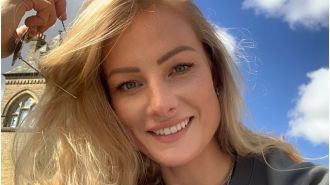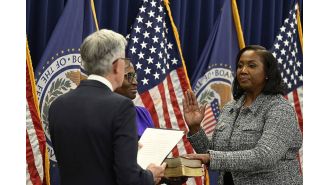A Hospital’s Secret Coronavirus Policy Separated Native American Mothers From Their Newborns
Pregnant Native American women were singled out for COVID-19 testing based on their race and ZIP code, clinicians say. While awaiting results, some mothers were separated from their newborns, depriving them of the immediate contact doctors recommend.

ALBUQUERQUE, N.M. — A prominent women’s hospital here has separated some Native American women from their newly born babies, the result of a practice designed to stop the spread of COVID-19 that clinicians and health care ethicists described as racial profiling.
Lovelace Women’s Hospital in Albuquerque implemented a secretive policy in recent months to conduct special coronavirus screenings for pregnant women, based on whether they appeared to be Native American, even if they had no symptoms or were otherwise at low risk for the disease, according to clinicians.
The hospital screens all arriving patients for COVID-19 with temperature checks and asks them whether they’ve been in contact with people who have the illness. But for soon-to-be moms who appeared to be Native American, there was an additional step, according to clinicians interviewed on the condition they not be named.
Hospital staff would compare the expectant mother’s ZIP code against a list of Indian reservation ZIP codes maintained by the hospital, known informally as the “Pueblos List,” a reference to New Mexico’s Pueblo Indian tribes. If the pregnant woman’s ZIP code matched one on the list, she was designated as a “person under investigation” for COVID-19, the clinicians said.
Lovelace does not use rapid COVID-19 tests, and babies were sometimes born before asymptomatic Native American mothers’ test results came back from the lab, a process that can take up to three days. As a result, one clinician said, the separation of Native American newborns from their asymptomatic mothers had taken place.
Such separations deprive infants of close, immediate contact with their mothers that doctors recommend.
“I believe this policy is racial profiling,” one clinician said. “We seem to be applying a standard to Native Americans that isn’t applied to everybody else. We seem to be specifically picking out patients from Native communities as at-risk whether or not there are outbreaks at their specific pueblo or reservation.”
The Navajo Nation and several Pueblo tribes in New Mexico have recorded some of the highest per capita rates of COVID-19 infection in the nation. In response to the pandemic, the state has designated several counties as hot spots, including some that are home to tribes with large numbers of cases. But 10 of the ZIP codes on the Lovelace Pueblos List reviewed by New Mexico In Depth and ProPublica do not fall within those hot spot counties, nor do all tribes within those ZIP codes have a high rate of infection.
A Lovelace spokeswoman acknowledged screening patients by geography, but she would not confirm or deny the existence of a policy based on ZIP codes as described by staff. Lovelace, whose owner is Nashville, Tennessee-based Ardent Health Services, is Albuquerque’s largest privately owned hospital system.
“Part of our screening process includes identifying and testing patients who reside in high-risk areas such as nursing homes and regional hot spots of COVID-19 cases as recommended” by the Centers for Disease Control and Prevention, Lovelace spokeswoman Whitney Marquez wrote in a May 21 email.
But CDC guidelines for evaluating COVID-19 risk among pregnant patients do not mention geography or ZIP code of residence. The guidelines instead state that only pregnant patients with COVID-19 symptoms or recent high-risk contacts with COVID-19 patients should be treated as suspected cases.
“Regardless of pending test results, pregnant individuals who are asymptomatic at the time of admission and have no history of high-risk contact should not be considered to be suspected cases,” the CDC guidelines note.
In a follow-up email, Marquez said Lovelace’s residential geography screening applied to all patients: “Any patient admitted to the hospital for any reason from a designated hot spot region is tested for COVID-19 as a PUI (person under investigation), per CDC guidance.”
Marquez’s claim was disputed by several clinicians who work in the hospital. Only ZIP codes with significant populations of Native Americans appeared on the list. Patients who did not appear to be Native American were not subject to further screening based on the ZIP code list, they said.
The two other large hospitals in Albuquerque said they did not have a policy like the one described by clinicians at Lovelace. Mothers are not determined to be suspected COVID-19 cases based only on their home ZIP code or their appearance, officials at Presbyterian Hospital and the University of New Mexico Hospital said. Nor are asymptomatic mothers’ newborns separated for isolation pending test results at those other hospitals.
At Lovelace, only women who appear to be Native American were singled out for the additional examination, even if they showed no symptoms and had not been in contact with a person who has tested positive for the illness, clinicians said.
“This isn’t about where you live or if you live in a hot spot — it’s about whether someone thinks you look Native,” a clinician explained. “The only people for whom we’ve been told to check ZIP codes are patients who appear to be Native.”
Health care ethicists said the practice described by the clinicians raises troubling questions about bias, trust and informed patient consent.
Saskia Popescu, a senior infection prevention epidemiologist at George Mason University in Fairfax, Virginia, said such policy decisions wouldn’t make sense from an infection control or epidemiology perspective, and they could create or exacerbate trust issues toward health care among Native American patients.
“There is a lot of room for error and a lot of assumptions,” she noted. “You’re assuming their mailing address is where they live, and they’ve been exposed or not exposed based on where they live. It doesn’t match public health guidance.”
Popescu said she understood why the hospital might place someone under investigation if they came from high-risk settings like nursing homes, but she questioned how a case could be made for doing so based on a home ZIP code.
“I don’t really know how well you can make the case that if a mom is asymptomatic, if she is reporting no known exposures to sick people, how you can make the case for keeping that baby in the NICU, separated,” Popescu said.
A copy of the Lovelace list reviewed by New Mexico In Depth and ProPublica contains names of tribes next to each of 22 associated ZIP codes. Native Americans have a much higher COVID-19 rate overall than other populations in New Mexico, but most of the tribes on the list have a low prevalence of the illness. For instance, the ZIP code for Cochiti Pueblo had recorded zero cases as of Tuesday; the ZIP code for Picuris Pueblo had just one. An additional eight ZIP codes had 7 or fewer cases.
An internal communication reviewed by New Mexico In Depth and ProPublica suggests the intent was to include all Indian reservations on the ZIP code list. But if so, the list is inexplicably incomplete.
All 19 New Mexico Indian Pueblos and the Mescalero Apache tribe are named next to a ZIP code on the list, and the Navajo Nation is named next to five ZIP codes. (Several Pueblo Indian tribes share some ZIP codes.) But missing from the list are the Jicarilla Apache tribe and three outlying Navajo communities: To’hajiilee, Ramah and Alamo. Also missing are numerous ZIP codes in the northwest part of the state with significant Native populations — and COVID-19 outbreaks.
Marquez did not provide a list of “designated hot spot” regions or ZIP codes despite repeated requests, other than stating that New Mexico hot spot regions “have been determined by the New Mexico Department of Health.”
But the state defines COVID-19 geographic hot spots by county, not ZIP codes, spokesman David Morgan wrote in an email.
“Hospitals have the latitude to decide on who to test, but no testing decisions should be made arbitrarily solely on the basis of race or ethnicity,” State Epidemiologist Michael Landen wrote in an email Thursday.
Referring to a map on the state Health Department’s online COVID-19 dashboard, Human Services Department spokeswoman Jodi McGinnis Porter listed the counties of San Juan, McKinley, Sandoval, Bernalillo and Doña Ana as state-designated hot spots.
Twelve of the 22 ZIP codes, which are home to 14 tribes on the list, have very few positive COVID-19 cases, according to publicly available Health Department data. Those ZIP codes are shaded green, or have no color, on the state data portal, signifying they have the lowest number of cases compared with other areas.
In other words, the Pueblos List contains low-risk ZIP code areas that include particular tribes but do not include other ZIP codes falling within counties deemed to be COVID-19 hot spots by the state — even those that contain large swaths of the heavily hit Navajo Nation.
Usually, Lovelace officials announce new policies by emailing links to staff. But that was not done in this case. Instead, supervisors read the policy aloud at the beginning of each shift, clinicians said.
The verbal readings didn’t mention that Native American mothers had to provide informed consent to be tested or separated from their newborn, a clinician said. That ambiguity appears to have caused confusion among staff.
One clinician said that Native American mothers were given an opportunity to decline separation from their infants.
But another clinician said some staff did not know patients had an option to do so for several weeks in April and May. “I don’t believe that patients were given an opportunity to decline testing or separation from their babies,” that clinician said. “This is a violation of informed consent, which is a foundation of modern health care.”
Marquez, the hospital spokeswoman, disputed the claim. She said that Lovelace provides all patients suspected or confirmed of having COVID-19 with information about the risks of remaining with their newborns. “Some patient[s] opt to keep their baby with them,” she said.
At least part of the issue lies in the type of tests done to detect COVID-19. Several Albuquerque hospitals, including Presbyterian and the University of New Mexico, use new rapid COVID-19 tests that yield results as quickly as two hours.
Lovelace, however, uses slower tests. Marquez would not explain why Lovelace did not deploy more rapid tests.
Nicolle L. Gonzales, a Navajo nurse midwife who worked at Lovelace for two years, first heard about the ZIP code policy from a colleague at the hospital last month.
Gonzales, who founded and directs the Changing Woman Initiative, a Native American women-led health collaborative in Santa Fe, New Mexico, said informed consent is an important concern for Native American patients
“You know, if you’re a Native person in an all-white setting, how do you speak up for yourself?” she asked. “There is no way to measure whether you’re being racially profiled or racially excluded from a norm [of treatment] that’s happening or not happening with others.”
Several Lovelace clinicians voiced concern about newborn separations and delayed breastfeeding, which can reduce the odds of successful breastfeeding later on, denying health benefits to mothers and their babies. For babies, breastfeeding can benefit immune system and brain development. Mothers who breastfeed have lower risks of breast cancer.
“Unless there is a life-threatening issue, we do not take babies from their moms,” a clinician explained. “It is standard practice and policy for babies to be immediately put on the mother, before and during the cutting of the umbilical cord, and to leave them there for at least an hour.”
For some health care ethicists, the policy described by the Lovelace clinicians recalled the federal government’s long, troubling history of separating Native American infants from their mothers. For others, it appeared uncomfortably similar to the disparate treatments of minorities in previous epidemics.
“This raises the specter of the HIV/AIDS pandemic in the 1980s,” said Barbara Gurr, associate professor of women’s, gender and sexuality studies at University of Connecticut and author of “Reproductive Justice: The Politics of Healthcare for Native American Women.” Gurr recalled a fear-driven bias against Haitian immigrants and gay men as HIV/AIDS spread. “Certain people were understood to be the bearers of the disease, in this kind of contaminating way, right? I think we’re running the risk of doing it again in the COVID pandemic.”
Ethicists also worried about the lingering effects of a policy based on ZIP codes. It could deter Native Americans from seeking hospital obstetric care, said Ann Mongoven, associate director of health care ethics at the Markkula Center for Applied Ethics at Santa Clara University in California.
“There’s a real concern that this policy could discourage people who absolutely should have hospital births,” she said.
Bryant Furlow is a reporter for New Mexico In Depth.
We’re reporting on birth and newborn care at Lovelace Women’s Hospital. We’d like to hear from you to help us understand your experiences. We appreciate you sharing your story, and we take your privacy seriously. ProPublica is gathering this information for our reporting, not for immediate publication.






